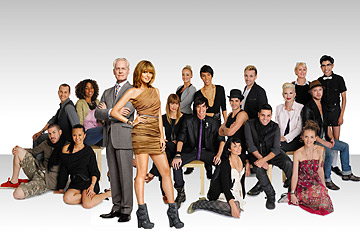
Reality TV wears a lot of hats: entertainment, talent search, portrait of culture at its most vapid and voyeuristic. But it has another, lesser-known function: spicing up bland college courses.
In the spring issue of Journal on Excellence in College Teaching, Brad van Eeden-Moorefield, an associate professor of human development and family studies at Central Michigan University, presents the results of his 2006 study on the effects of modeling a research-methods class after Project Runway. The show that just began its eighth season makes budding fashion designers vie for a grand prize by competing in weekly challenges. And though it's hard to imagine a realm farther removed from the sexy world of fashion than a small-town campus in sleepy Mount Pleasant, Mich., van Eeden-Moorefield's Project M (the M is for Methodology) proved successful. By the end of the semester, 100% of the students said they thought the curriculum should be used in future classes. They reported being more invested and also retaining more material. And perhaps most important, they said they actually had fun in a class in which students are trained to write theses, academic papers and similarly mind-numbing (but necessary) stuff.
So what is it about Project Runway, a show that each week has German supermodel Heidi Klum dismissing a contestant with a cool "Auf Wiedersehen," that made the Michigan students dive into developing data-collection strategies and writing abstracts? The answer is, of course, the age-old spirit of competition. Although the most disappointing students weren't voted off the class roster at regular intervals, faculty and student judges ranked teams almost weekly in 11 challenges based on how the students applied research skills, whether in writing a literature review or understanding ethics. "It's human nature. People want to win. People want to excel," says Christine Walsh, who was a senior in the class when van Eeden-Moorefield first tried the method in 2006. "You can shove a bad test grade in your folder. When you're presenting in front of peers and professors, you want to be on your best game." (The prize and grand finale for Project M involved a grade bump, mentorship and presentation at a college-wide exhibition.)
There is also the element of reaching young people through a pop-culture platform, which turned a class that elicits soporific images of spreadsheets and bibliographies into something relatable. "Research methods is an important skill, even for people who [will never] inject lab rats with anything," says van Eeden-Moorefield, explaining that Project M made students less apprehensive about — and less bored by — the topic. He has continued to use the format since its 2006 debut and has achieved good if not better results by honing the method and incorporating suggestions from students, like giving second- and third-place winners a little prize action too.
In a 2004 study examining why people like reality TV, Steven Reiss, a professor emeritus of psychology at Ohio State University, found that reality shows allowed people to repeatedly and vicariously experience some of their basic desires, specifically their yearning for status and vengeance, the latter being closely tied to human enjoyment of competition. "The message of reality television — that millions of people are interested in watching real-life experiences of ordinary people — implies that ordinary people are important," Reiss wrote. And injecting some student exhibitionism into a class often governed by teacher-centric lectures and handouts "helps break down some of that power hierarchy," van Eeden-Moorefield says.
But there are also factors particular to Project Runway and similar shows that came into play, one of the biggest being its interactive form of critique, which often comes from the show's resident mentor, Tim Gunn. University of Tennessee law professor Michael Higdon has been giving lectures for years on why teachers should be more like Gunn, a silver-haired, bespectacled fashionisto (and former academic) who guides contestants before they present their creations to the judges. Higdon believes there is an essential overlap between teaching and talent-competition reality shows like Project Runway — at their basic levels, individuals are given a particular task and critiqued on their different approaches to completing that task, and giving meaningful criticism that is specific and informed, delicate yet honest, is integral to improvement. "Tim Gunn is the master of critique," Higdon says. "His slogan is 'Make it work.' There are some teachers who will just dictate to their students, and that just doesn't work."
Van Eeden-Moorefield says he took on Gunn's role and let others do the judging. In presenting their work to a panel of judges, students, like the competing designers on TV, are exposed to a variety of critical perspectives, something van Eeden-Moorefield says is important in getting them to assess their approaches without getting defensive. In one challenge, students were asked to summarize previous research regarding their particular topic but to do so in the form of comic-book storyboards, a quirky assignment that could elicit very different reactions from peers compared with professors'. "You're getting feedback, you're getting challenged," Walsh says. "Part of it isn't awesome, but that's the reality of life."
Although van Eeden-Moorefield's study merely presents a promising method, Jane Cha, executive producer and co-creator of Project Runway, says she can see how the show's formulaic approach would be appealing to teachers. "[The contestants] hit on the same beats every time, but they can still be creative," says Cha, who understands all too well the burden teachers face in returning to the same basic material year after year. "The designers know what to expect," she says. "So the onus is on us to make [the challenges] more interesting every single time."
